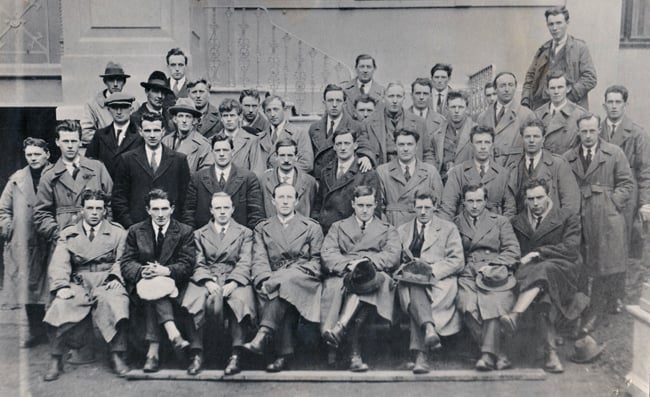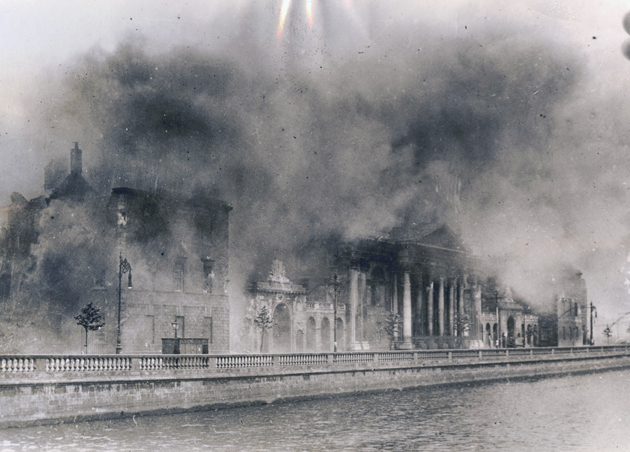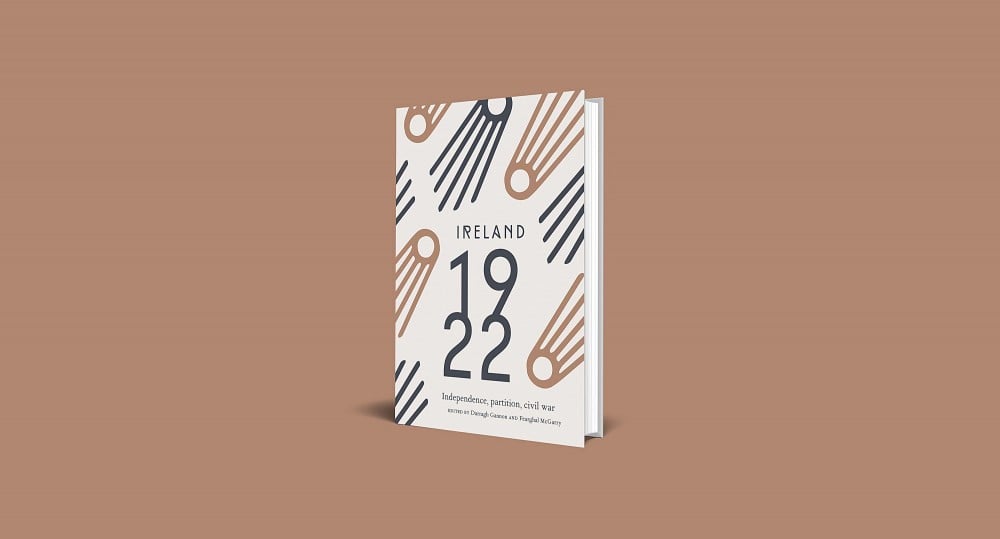28 June 1922: The Assault on the Four Courts
Defending The Republic. The IRA Field Army and The Civil War’s Conventional Phase
by John Borgonovo
The Irish civil war began on 28 June 1922 when the National Army attacked the forces of the IRA Army Executive at the Four Courts in Dublin. The garrison surrendered on 30 June with comparatively few casualties, beyond the destruction of much of the Four Courts complex, including the invaluable Public Records Office. Subsequent IRA resistance took the form of a conventional phase of fighting, which lasted for roughly seven weeks, until early August 1922, followed by a longer phase of guerrilla war. This essay focuses on the first phase of combat, when the anti-Treaty IRA maintained an army in the field.
During the War of Independence, the Irish Republican Army (IRA) was a largely decentralised organisation. While IRA General Headquarters GHQ) in Dublin issued broad policy guidelines and critiqued unit performances, it maintained little direct control over subordinate units beyond the capital. Individual brigades (subsequently superseded by divisions) practised collective decision-making at all levels. Units elected their own officers, armed and financed themselves, and planned their own operations.
It should be emphasised that the provincial IRA leadership was not consulted before the Anglo-Irish Treaty was signed; many officers appear to have been shocked by the subsequent acceptance of dominion status, which disestablished the Irish Republic.
While precise figures are elusive, it can be estimated that roughly 70–75% of IRA members opposed the Anglo-Irish Treaty.¹ Their numbers included most of the IRA’s guerrilla elite in Connaught and Munster. Following the ratification of the Treaty by Dáil Éireann, much of the country remained under the loose authority of the anti-Treaty IRA (hereafter called the IRA). In March/April 1922, the IRA’s Army Convention renounced the organisation’s allegiance to Dáil Éireann, elected a ruling Army Executive, and established a new general headquarters in the Four Courts. The Army Executive remained divided, however, over the best path forward. Militants such as Rory O’Connor and Ernie O’Malley wanted to overthrow the Provisional Government and establish an IRA military dictatorship to ‘defend the Irish Republic’. If necessary, they would resume the war with Britain to reunify the movement. Moderates, especially Munster officers within Liam Lynch’s powerful First Southern Division, recognised their lack of public support, opposed a dictatorship, and sought a peace settlement that retained national unity but protected the Republic.
Internally divided, the IRA surrendered the initiative to the Provisional Government, which was constructing a new National Army and expanding its civilian support via a highly efficient propaganda machine. The National Army relied on support from the pro-Treaty GHQ and active Dublin units, along with (largely ineffective) midland units, and more substantial brigades in Longford, East Clare, Donegal, and East Limerick. It also recruited from the wider public, including Irish First World War veterans.²
The Army Unification Agreement, a proposed peace settlement negotiated in May 1922, was opposed by hardliners on the IRA Army Executive, which openly split into moderate and militant factions. Briefly the IRA maintained two parallel headquarters and chiefs of staff (Liam Lynch and Joe McKelvey). Despite their belligerence, the militants made no practical preparations for hostilities with Provisional Government (hereafter called Free State) forces. At the outset of fighting in Dublin during late June 1922, the National Army essentially decapitated the IRA by capturing or killing much of its leadership and headquarters staff inside the Four Courts and in the subsequent city fighting. As the IRA fought a losing battle in Dublin, it took a few days for the IRA to reorganise under the new Chief of Staff, Liam Lynch.³ He reconstituted an army headquarters in Munster largely by repurposing his First Southern Division staff, and gathered what I call the IRA ‘field army’.
The IRA enjoyed a numeric advantage in terms of overall personnel, but it was heavily outgunned by the National Army. At the start of hostilities, the National Army’s strength was about 8,000 armed soldiers, a figure that grew to 14,000 by mid-August 1922.⁴ Supplied by the British government, Free State forces possessed field artillery,numerous armoured cars and vehicles and an abundance of machine-guns, which amplified their firepower in subsequent engagements. Unlike the IRA, the National Army paid its soldiers, providing a financial incentive for enlistment. It also possessed the funds to purchase supplies, while the IRA was forced to commandeer them. Though the IRA possessed a paper strength of almost 84,000 Volunteers on 1 July 1922, it could only arm a small portion of them. A reasonable estimate of IRA fighting strength during the conventional phase would be about 3,000–4,000 armed fighters, supported by tens of thousands of unarmed male and female combatants.
From the outset, IRA leaders debated whether to stand and fight the National Army in towns and cities, or to disperse and resume guerrilla tactics. While the IRA had been built as a guerrilla organisation, many leaders felt that a retreat without resistance would demoralise both the IRA rank-and-file and their civilian supporters. Liam Lynch sought to concentrate forces in Munster along a defensive line from Limerick city to Waterford city, which would absorb Free State pressure. IRA units elsewhere would use guerrilla tactics to weaken the National Army, while the Dublin IRA blockaded the capital to disrupt the flow of troops and supplies to different battlefronts. The plan faltered at the first hurdle, however, because the badly damaged Dublin IRA lacked the strength to seal off the city. Dublin became a secure base for the National Army to build up its strength, which was then deployed along interior lines of communication to hard-pressed locales.

First Southern Division delegates to the proscribed IRA Army Convention at the Mansion House, March 1922 (Image: Kilmainham Gaol archives; reproduced by permission)
IRA units initially defended their territory from Free State incursions,with varying degrees of success. The IRA in Sligo and Louth achieved noteworthy victories, while in Munster, columns of the IRA’s First Southern Division fighters captured a number of National Army bases while clearing their area of Free State troops. The IRA quickly faltered, however, when units operated beyond their home areas, especially in places with weak IRA organisations. Determined IRA units in Mayo, Sligo, Louth and Wexford fought largely unsupported, and were soon pushed out of urban areas by Free State troops possessing superior numbers and firepower. Perhaps the most decisive moment occurred during the Battle of Limerick City, after hundreds of experienced Munster IRA fighters descended on the Free Stateforces there.⁵ Instead of immediately attacking his outnumbered opponents, Liam Lynch agreed to a truce in an attempt to secure the neutrality of the Free State’s forces in East Clare and East Limerick (via their commanders Michael Brennan and Donnacha O’Hannigan, an old friend of Lynch’s). The truce allowed Free State reinforcements from Dublin to enter Limerick, attack the IRA, and drive them from the city after a week of tough fighting.Thereafter, the IRA fought on the defensive.
Only in the IRA-controlled ‘Munster Republic’ did the IRA manage to concentrate its forces adequately. There, the IRA formed a field army comprised of the fighting elite of its First and Second southern divisions from counties Cork, Kerry, Limerick, Tipperary and Waterford. For most of July it held a line from Limerick to Waterford. Battle fronts were defended by a number of flying columns from individual brigades and battalions, each of which usually numbered between twenty and one hundred armed fighters. They were relatively well-supplied with rifles, machineguns and landmines, while lorries (seized from local businesses), and commandeered railways, allowed rapid movement. These forces were reinforced by poorly armed local units, which provided scouting, logistics and other support services. Cumann na mBan was also mobilised to carry messages, treat the wounded, collect information, scout, transport arms and feed and billet IRA troops.⁶ Overall, the IRA field army performed poorly in Waterford city but fairly well during heavy fighting around Kilmallock in County Limerick and parts of Tipperary, when it managed to hold off superior Free State forces for a few weeks.⁷ Yet, the overall republican effort was somewhat confused, haphazard and undermined by the IRA’s decentralised structure, which made it difficult to command and control disparate, independently minded units and their leaders.
Throughout July, the IRA used Cork city as its unofficial capital, and took advantage of its amenities.⁸ Critical funds (an estimated £100,000) were raised through the seizure of import and export duties at the Cork Customs House. This allowed the IRA to pay for its supplies instead of commandeering them from local businesses, which was unpopular. An IRA ‘civil affairs’ office issued steep income tax bills to local merchants who had been avoiding payment. IRA engineers began to produce numerous armoured cars in city workshops, while Erskine Childers and Mary MacSwiney used the Cork Examiner newspaper to, at least partially, offset the powerful Free State propaganda machine. Yet, the republicans made little effort to mobilise civilian support, and persistently underestimated how much the public was turning against them.⁹
The IRA in the Munster Republic was spread thin. The ‘line fighting’ sapped the IRA’s fighting strength, while towns and cities had to be defended by weak units logistically supported by Cumann na mBan. Along its exposed southern coast, the IRA garrisoned ports and Coast Guard stations, and in late July started to destroy landing piers at potential landing spots in Cork and Kerry. These flimsy defences could not, however, prevent the Munster Republic from collapse in early August, following a series of Free State amphibious landings.
On 2 August the National Army landed 500 soldiers at Fenit, County Kerry, and seized Tralee after a brief but tough fight. A more spectacular operation occurred in county Cork in the early hours of 8 August. Led by Emmet Dalton, the National Army landed almost 500 soldiers at Passage West and advanced on Cork city. Simultaneously, 200 troops disembarked at Youghal, while another 180 landed at Union Hall. For three days in the Cork suburb of Douglas, the National Army battled up to 300 IRA Volunteers, most of whom had been rushed from different battle fronts. Like other set-piece contests, superior Free State firepower won the day, after its field artillery and armoured cars blasted republican defences. By then, the IRA had evacuated its Munster capital, and dispersed the IRA field army before it could be encircled by slow-moving Free State forces. Following IRA policy, retreating units systematically blocked roads, bridges and railways, and burned police and military barracks that could be used by the National Army; actions which only further antagonised the local population. Defeated and harried, the various IRA columns returned to their home areas and commenced a guerrilla campaign against the Free State.
IRA Chief of Staff Liam Lynch and his fellow commanders had never fully committed to a conventional warfare strategy. Even when the IRA stalled Free State advances in Limerick city, Kilmallock, and Douglas, Lynch avoided over-committing his fighting forces. Throughout this phase, he and his colleagues displayed a guerrilla warfare mind-set by disengaging and retreating whenever faced with superior forces. While this strategy had been successful against the British in the War of Independence, during the conventional phase of the civil war it thoroughly demoralised his IRA troops and their civilian supporters. IRA leaders underestimated their dependence on popular support. Its near collapse at the end of conventional fighting fatally compromised the ensuing guerrilla phase of the civil war. Within eight months, Liam Lynch was dead, the IRA organisation smashed, and the most committed republican fighters thoroughly defeated.
With many Volunteers unwilling to surrender, the IRA Chief of
Staff Frank Aiken ordered his forces to ‘dump arms’ on
24 May 1923. The Irish Republic, which had briefly endured in
Munster and the other provinces,
was no more.
Extracted from Ireland 1922 edited by Darragh Gannon and Fearghal McGarry and published by the Royal Irish Academy with support from the Department of Tourism, Culture, Arts, Gaeltacht, Sport and Media under the Decade of Centenaries 2012-2023 programme. Click here to view more articles in this series, or click the image below to visit the RIA website for more information.






















